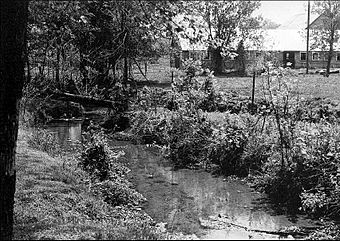Rattlesnake Springs facts for kids
Quick facts for kids |
|
|
Rattlesnake Springs
|
|
 |
|
| Nearest city | Cleveland, Tennessee |
|---|---|
| NRHP reference No. | 75001734 |
| Added to NRHP | September 5, 1975 |
Rattlesnake Springs is a very important historical place in Bradley County, Tennessee. It was added to the National Register of Historic Places in 1975. This site played a big role in the history of the Cherokee Nation and the difficult time known as the Trail of Tears.
Contents
Discovering Rattlesnake Springs' Past
Rattlesnake Springs is found in a quiet, country area of Bradley County. It is northeast of Cleveland and southeast of Charleston. Today, it is part of a private dairy farm.
A Key Place for the Cherokee Nation
This spot was very important to the eastern Cherokee Nation. It was also key during a sad time called the Cherokee removal. The Cherokee people held their very last big meeting, or Council, here. This happened before they were forced to leave their homes.
In 1838, about 13,000 Cherokees were gathered at Rattlesnake Springs. They were held there by federal troops. From this site, they began a long, hard journey to Oklahoma. This journey is sadly known as the Trail of Tears.
Military Camps and Hardships
Federal troops and soldiers from Tennessee and Georgia set up two military camps nearby. These were called Camp Foster and Camp Worth. They were used to watch over the Cherokees before they were moved. Other camps, like Fort Cass in Charleston, were also used for this purpose.
Life at the springs was very hard for the Cherokees. More than 200 Cherokees became sick and died here. This happened before they even started the long journey.
Remembering the History
A local historian and former Cleveland mayor, James F. Corn, wrote about Rattlesnake Springs. His 1959 book, "Red Clay and Rattlesnake Springs," tells the story of the Cherokees in Bradley County.
The site was officially recognized for its history on September 5, 1975. It was then listed on the National Register of Historic Places. A special marker once stood near the site to tell its story.



